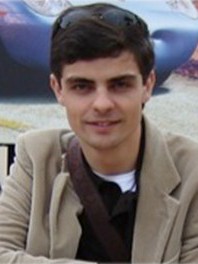resumo
beta-Substitued-meso-tetraphenylporphyrins with 5,10-dioxobenzo[g]- or 5,6-dioxobenzo[h]chromene, pyrano[3,2-c]coumarin and benzopyran moieties and the corresponding Zn(II), Cu(II) and Ni(II) complexes were studied by electrospray mass spectrometry (ESI-MS) and tandem mass spectrometry (MS/MS). These heterocyclic moieties have well established pharmacological activities and as such the introduction of these motifs into the p-pyrrolic position of the porphyrin macrocycle can alter the properties of the macrocycle and can produce new molecules with dual functions. The free base and Zn(II) complexes showed, in the ESI-MS spectra, the [M+H](+) ions while the Cu(II) and Ni(II) complexes showed the M+center dot ions. The [M+H](+) and M+center dot ions were induced to fragment and the corresponding ESI tandem mass spectra (MS/MS) were analyzed. The main fragmentation mechanism occurs in general via the retro hetero-Diels Alder pathway while unexpected fragmentations or rearrangements were observed principally with the Zn(II) complexes. The analysis of the fragmentation pattern of all complexes indicates that the presence or absence of the carbonyl function in the beta-substituent led to the formation of secondary fragments. The differentiation of the isomers 2a and 2b was only possible by comparison of their MS/MS spectra. (C) 2013 Elsevier B.V. All rights reserved.
palavras-chave
ELECTROSPRAY-IONIZATION; PORPHYRINS; FRAGMENTATIONS; DERIVATIVES; COMPLEXES
categoria
Physics; Spectroscopy
autores
Menezes, JCJMDS; Neves, MGPMS; Cavaleiro, JAS; Barros, C; Santos, SM; da Silva, FD; Ferreira, VF; Domingues, MRM
nossos autores
agradecimentos
We gratefully acknowledge University of Aveiro, Fundacao para a Ciencia e a Tecnologia (FCT, Portugal), European Union, QREN, FEDER and COMPETE for funding the QOPNA research unit (project PEst-C/QUI/UI0062/2011), the Portuguese National NMR Network and Portuguese Mass Spectrometry Network (RNEM) (REDE/1504/REM/2005) also supported by funds from FCT. JCJMDS Menezes thanks QOPNA for a research grant and SM Santos acknowledges FCT for the post-doc grant SFRH/BPD/64752/2009. Thanks are also due to the FCT-CAPES (Coordenacao de Aperfeicoamento de Pessoal de Nivel Superior, Brazil) collaborative action for funding.


